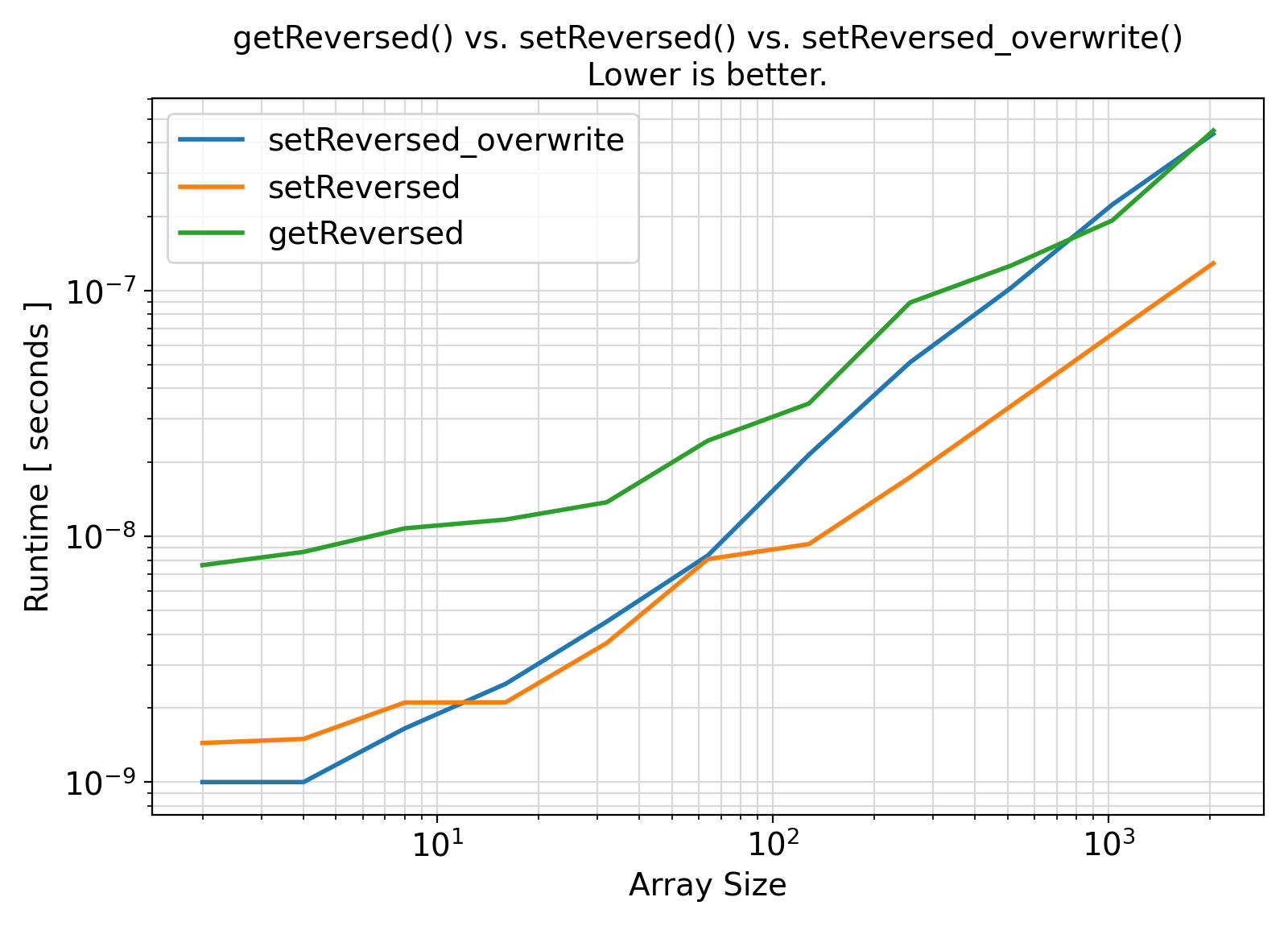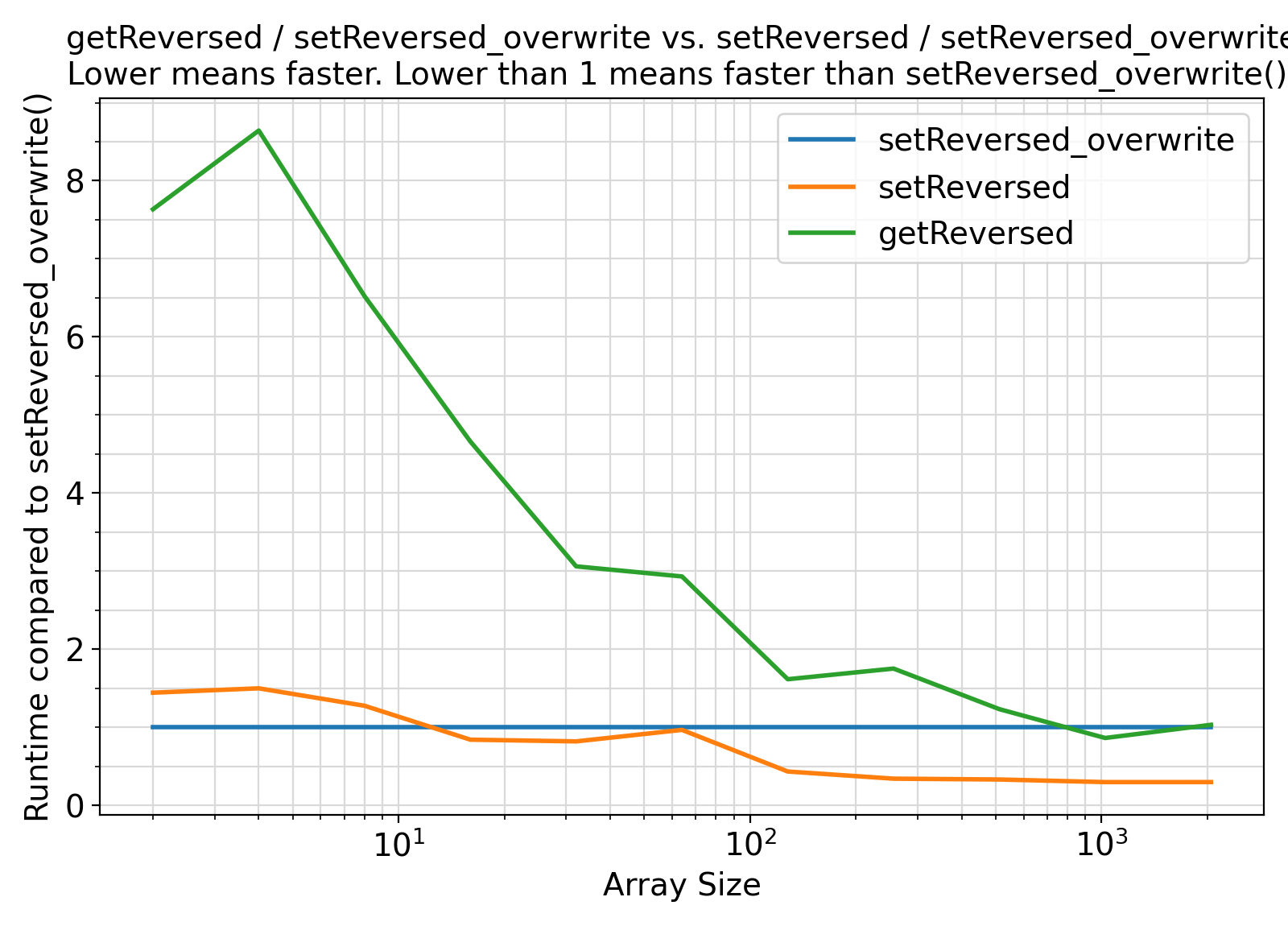This module contains procedures and generic interfaces for reversing the order of elements in arrays of various types.
More...
This module contains procedures and generic interfaces for reversing the order of elements in arrays of various types.
- Benchmarks:
Benchmark :: The runtime performance of setReversed vs. direct reversing ⛓
4 use iso_fortran_env,
only:
error_unit
14 integer(IK) :: fileUnit
15 integer(IK) ,
parameter :: nsize
= 11_IK
16 integer(IK) ,
parameter :: NBENCH
= 3_IK
17 integer(IK) :: arraySize(nsize)
18 real(RK) :: dummySum
= 0._RK
19 real(RK) ,
allocatable :: array(:), arrayReverse(:)
20 type(bench_type) :: bench(NBENCH)
22 bench(
1)
= bench_type(name
= SK_
"getReversed", exec
= getReversed, overhead
= setOverhead)
23 bench(
2)
= bench_type(name
= SK_
"setReversed", exec
= setReversed, overhead
= setOverhead)
24 bench(
3)
= bench_type(name
= SK_
"setReversed_overwrite", exec
= setReversed_overwrite , overhead
= setOverhead)
26 arraySize
= [(
2_IK**isize, isize
= 1_IK, nsize )]
28 write(
*,
"(*(g0,:,' '))")
29 write(
*,
"(*(g0,:,' '))")
"getReversed() vs. setReversed() vs. setReversed_overwrite()"
30 write(
*,
"(*(g0,:,' '))")
32 open(newunit
= fileUnit, file
= "main.out", status
= "replace")
34 write(fileUnit,
"(*(g0,:,','))")
"arraySize", (bench(i)
%name, i
= 1, NBENCH)
36 loopOverArraySize:
do isize
= 1, nsize
39 call setResized(arrayReverse, arraySize(isize))
40 write(
*,
"(*(g0,:,' '))")
"Benchmarking with rank", arraySize(isize)
43 bench(i)
%timing
= bench(i)
%getTiming(minsec
= 0.05_RK)
46 write(fileUnit,
"(*(g0,:,','))") arraySize(isize), (bench(i)
%timing
%mean, i
= 1, NBENCH)
48 end do loopOverArraySize
49 write(
*,
"(*(g0,:,' '))") dummySum
50 write(
*,
"(*(g0,:,' '))")
60 subroutine setOverhead()
65 dummySum
= dummySum
+ sum(array)
68 subroutine getReversed()
76 subroutine setReversed()
84 subroutine setReversed_overwrite()
Allocate or resize (shrink or expand) an input allocatable scalar string or array of rank 1....
Generate and return an output array whose elements are the reversed-order elements of the input array...
Reverse the order of the elements of the input array, such that   array = array(lenArray:1:-1),...
Generate and return an object of type timing_type containing the benchmark timing information and sta...
Generate and return a scalar or a contiguous array of rank 1 of length s1 of randomly uniformly distr...
This module contains procedures and generic interfaces for resizing allocatable arrays of various typ...
This module contains procedures and generic interfaces for reversing the order of elements in arrays ...
This module contains abstract interfaces and types that facilitate benchmarking of different procedur...
This module contains classes and procedures for computing various statistical quantities related to t...
This module defines the relevant Fortran kind type-parameters frequently used in the ParaMonte librar...
integer, parameter RK
The default real kind in the ParaMonte library: real64 in Fortran, c_double in C-Fortran Interoperati...
integer, parameter IK
The default integer kind in the ParaMonte library: int32 in Fortran, c_int32_t in C-Fortran Interoper...
integer, parameter SK
The default character kind in the ParaMonte library: kind("a") in Fortran, c_char in C-Fortran Intero...
This is the class for creating benchmark and performance-profiling objects.
Example Unix compile command via Intel ifort compiler ⛓
3ifort -fpp -standard-semantics -O3 -Wl,-rpath,../../../lib -I../../../inc main.F90 ../../../lib/libparamonte* -o main.exe
Example Windows Batch compile command via Intel ifort compiler ⛓
2set PATH=..\..\..\lib;%PATH%
3ifort /fpp /standard-semantics /O3 /I:..\..\..\include main.F90 ..\..\..\lib\libparamonte*.lib /exe:main.exe
Example Unix / MinGW compile command via GNU gfortran compiler ⛓
3gfortran -cpp -ffree-line-length-none -O3 -Wl,-rpath,../../../lib -I../../../inc main.F90 ../../../lib/libparamonte* -o main.exe
Postprocessing of the benchmark output ⛓
3import matplotlib.pyplot
as plt
9methods = [
"setReversed_overwrite",
"setReversed",
"getReversed"]
11df = pd.read_csv(
"main.out")
17ax = plt.figure(figsize = 1.25 * np.array([6.4,4.6]), dpi = 200)
21 plt.plot( df[
"arraySize"].values
26plt.xticks(fontsize = fontsize)
27plt.yticks(fontsize = fontsize)
28ax.set_xlabel(
"Array Size", fontsize = fontsize)
29ax.set_ylabel(
"Runtime [ seconds ]", fontsize = fontsize)
30ax.set_title(
"getReversed() vs. setReversed() vs. setReversed_overwrite()\nLower is better.", fontsize = fontsize)
34plt.grid(visible =
True, which =
"both", axis =
"both", color =
"0.85", linestyle =
"-")
35ax.tick_params(axis =
"y", which =
"minor")
36ax.tick_params(axis =
"x", which =
"minor")
44plt.savefig(
"benchmark.getReversed_vs_setReversed.runtime.png")
50ax = plt.figure(figsize = 1.25 * np.array([6.4,4.6]), dpi = 200)
53plt.plot( df[
"arraySize"].values
54 , np.ones(len(df[
"arraySize"].values))
59plt.plot( df[
"arraySize"].values
60 , df[
"setReversed"].values / df[
"setReversed_overwrite"].values
63plt.plot( df[
"arraySize"].values
64 , df[
"getReversed"].values / df[
"setReversed_overwrite"].values
68plt.xticks(fontsize = fontsize)
69plt.yticks(fontsize = fontsize)
70ax.set_xlabel(
"Array Size", fontsize = fontsize)
71ax.set_ylabel(
"Runtime compared to setReversed_overwrite()", fontsize = fontsize)
72ax.set_title(
"getReversed / setReversed_overwrite vs. setReversed / setReversed_overwrite\nLower means faster. Lower than 1 means faster than setReversed_overwrite().", fontsize = fontsize)
76plt.grid(visible =
True, which =
"both", axis =
"both", color =
"0.85", linestyle =
"-")
77ax.tick_params(axis =
"y", which =
"minor")
78ax.tick_params(axis =
"x", which =
"minor")
79ax.legend ( [
"setReversed_overwrite",
"setReversed",
"getReversed"]
86plt.savefig(
"benchmark.getReversed_vs_setReversed.runtime.ratio.png")
Visualization of the benchmark output ⛓
Benchmark moral ⛓
- The procedures under the generic interface setReversed with in-place array reversal (corresponding to
setReversed_overwrite() in the benchmark) tend to be significantly faster than the functional-interface procedures getReversed.
The reason is likely the extra copy required with the functional interface.
- Test:
- test_pm_arrayReverse
Final Remarks ⛓
If you believe this algorithm or its documentation can be improved, we appreciate your contribution and help to edit this page's documentation and source file on GitHub.
For details on the naming abbreviations, see this page.
For details on the naming conventions, see this page.
This software is distributed under the MIT license with additional terms outlined below.
-
If you use any parts or concepts from this library to any extent, please acknowledge the usage by citing the relevant publications of the ParaMonte library.
-
If you regenerate any parts/ideas from this library in a programming environment other than those currently supported by this ParaMonte library (i.e., other than C, C++, Fortran, MATLAB, Python, R), please also ask the end users to cite this original ParaMonte library.
This software is available to the public under a highly permissive license.
Help us justify its continued development and maintenance by acknowledging its benefit to society, distributing it, and contributing to it.
- Copyright
- Computational Data Science Lab
- Author:
- Fatemeh Bagheri, Wednesday 12:20 AM, October 13, 2021, Dallas, TX



